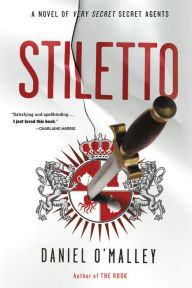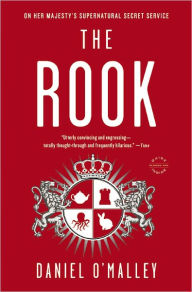5 Ways Daniel O’Malley’s Stiletto Doubles Down on Skullduggery
 An often-overlooked aspect of writing a book series is the fact that after an author expends great effort creating a universe and establishing its rules in book one, the only way to move the story forward in book two is to throw half of it out the window and start changing things. Eternal, static universes are kind of…boring. Daniel O’Malley get it. In his terrific debut, The Rook, he crafted a truly remarkable world, in which Great Britain is home to the Checquy, a secret and supernatural agency that battles magical threats against the country and the world. He also introduced the group’s ancient enemies The Grafters, a Belgian group who augment themselves through surgery and genetic modification.
An often-overlooked aspect of writing a book series is the fact that after an author expends great effort creating a universe and establishing its rules in book one, the only way to move the story forward in book two is to throw half of it out the window and start changing things. Eternal, static universes are kind of…boring. Daniel O’Malley get it. In his terrific debut, The Rook, he crafted a truly remarkable world, in which Great Britain is home to the Checquy, a secret and supernatural agency that battles magical threats against the country and the world. He also introduced the group’s ancient enemies The Grafters, a Belgian group who augment themselves through surgery and genetic modification.
Stiletto
Stiletto
Hardcover $26.00
So, what does O’Malley do in the sequel, Stiletto? He transforms the Grafters into allies of the Checquy, upsetting the balance of his own universe to incredible effect. As a result, the book is just as fun as The Rook, even as it deepens the experience and heightens the tension. Here are five reasons Stiletto is an even better read.
Mo’ characters, mo’ problems
Everyone who loved The Rook‘s lead character, Myfanwy Thomas, will be releived to know she’s back, but Rook Thomas isn’t the sole focus this time—in fact, for long stretches, she’s nowhere to be found. This is all to the good, however; too many sequels make the mistake of reconstructing the main character’s conflicts from the first book. Instead, O’Malley allows Thomas to be the confident, established leader she was at the end of book one, while introducing new characters who bring new perspectives. The most enjoyable of these are Pawn Felicity Clements, who can see into and through most inanimate objects, and Odette, a member of Grafter royalty. The two are opposites who can’t quite accept that they’re now allies—so when Pawn Clements is assigned to protect Odette, it makes for a delightful conflict, an urban fantasy version of a buddy movie. Their mutual outrage deepens our understanding of both sides.
The repartee
There are writers who craft intricate plots, writers who breathe life into incredible characters, and writers who pen lines you want to quote all day long. O’Malley is one of the rare finds who regularly manages all three. The Rook‘s breathless, tongue-in-cheek tone is back in full force. The conflict between Grafters and Checquy offers fresh opportunities to gift readers with hilariously dry lines and smartass observations, particularly from Odette, who quickly becomes a favorite character. Seeing things from the Grafter point of view is awesome, because the Checquy are just as mysterious and weird to them as they are to us, inspiring darkly hilarious musings about their true nature (“I expect there will be some little monster who doesn’t need to breathe air, or is actually a living song, or some such ludicrous atrocity.”)
So, what does O’Malley do in the sequel, Stiletto? He transforms the Grafters into allies of the Checquy, upsetting the balance of his own universe to incredible effect. As a result, the book is just as fun as The Rook, even as it deepens the experience and heightens the tension. Here are five reasons Stiletto is an even better read.
Mo’ characters, mo’ problems
Everyone who loved The Rook‘s lead character, Myfanwy Thomas, will be releived to know she’s back, but Rook Thomas isn’t the sole focus this time—in fact, for long stretches, she’s nowhere to be found. This is all to the good, however; too many sequels make the mistake of reconstructing the main character’s conflicts from the first book. Instead, O’Malley allows Thomas to be the confident, established leader she was at the end of book one, while introducing new characters who bring new perspectives. The most enjoyable of these are Pawn Felicity Clements, who can see into and through most inanimate objects, and Odette, a member of Grafter royalty. The two are opposites who can’t quite accept that they’re now allies—so when Pawn Clements is assigned to protect Odette, it makes for a delightful conflict, an urban fantasy version of a buddy movie. Their mutual outrage deepens our understanding of both sides.
The repartee
There are writers who craft intricate plots, writers who breathe life into incredible characters, and writers who pen lines you want to quote all day long. O’Malley is one of the rare finds who regularly manages all three. The Rook‘s breathless, tongue-in-cheek tone is back in full force. The conflict between Grafters and Checquy offers fresh opportunities to gift readers with hilariously dry lines and smartass observations, particularly from Odette, who quickly becomes a favorite character. Seeing things from the Grafter point of view is awesome, because the Checquy are just as mysterious and weird to them as they are to us, inspiring darkly hilarious musings about their true nature (“I expect there will be some little monster who doesn’t need to breathe air, or is actually a living song, or some such ludicrous atrocity.”)
The Rook
The Rook
In Stock Online
Paperback $19.99
The antagonists
That line provides a clear hint at the book’s central conflict: many on both sides of the merger don’t want it to happen, unable to forget they’ve spent their lives hating their enemy. Mysterious events around London begin to coalesce into a terrorist campaign by a shadowy group known rather bluntly as “The Antagonists,” who seem bent on destroying the alliance before it can take root. Rook Thomas, Pawn Clements, and Odette the Grafter find themselves in the eye of the storm, trying to hold the fragile peace together while getting to the bottom of the mystery, leading to suitably shocking revelations.
The Oblong of Mystery and Other Tales
Around this central conflict, O’Malley offers up a smörgåsbord of delightfully insane supernatural events that serve as amusing side-quests, beginning with the sequence that introduces Pawn Clements, summoned to investigate some odd disappearances with the advisory that she be prepared to be doused with urine. Her misadventure involves something called the Oblong of Mystery (quickly abbreviated to OOM), and the whole setup is classic Checquy, bizarre and violent and yet, somehow, hilarious. The book teems with big, weird ideas, which the Checquy unfailingly dispatch with a mixture of awe and workmanlike boredom.
The hidden depths
Ultimately, O’Malley’s story is concerned with the question of what it means to be human in this world. The Checquy regard the Grafters as insane monsters. The Grafters regard the Checquy as inhuman cockroaches who must be stamped out. Caught in the middle of these super-powered groups are the regular citizens—even the Checquy and Grafter children, innocent despite their heritage. All of this wildly imaginative chaos leads unerringly to an ending that’s both satisfying and, to put it plainly, fun.
It took Daniel O’Malley four long years to write this sequel. That time paid off. If the next book is half as good as this one, readers will happily wait as long as it takes to get here.
Read our interview with Daniel O’Malley.
The antagonists
That line provides a clear hint at the book’s central conflict: many on both sides of the merger don’t want it to happen, unable to forget they’ve spent their lives hating their enemy. Mysterious events around London begin to coalesce into a terrorist campaign by a shadowy group known rather bluntly as “The Antagonists,” who seem bent on destroying the alliance before it can take root. Rook Thomas, Pawn Clements, and Odette the Grafter find themselves in the eye of the storm, trying to hold the fragile peace together while getting to the bottom of the mystery, leading to suitably shocking revelations.
The Oblong of Mystery and Other Tales
Around this central conflict, O’Malley offers up a smörgåsbord of delightfully insane supernatural events that serve as amusing side-quests, beginning with the sequence that introduces Pawn Clements, summoned to investigate some odd disappearances with the advisory that she be prepared to be doused with urine. Her misadventure involves something called the Oblong of Mystery (quickly abbreviated to OOM), and the whole setup is classic Checquy, bizarre and violent and yet, somehow, hilarious. The book teems with big, weird ideas, which the Checquy unfailingly dispatch with a mixture of awe and workmanlike boredom.
The hidden depths
Ultimately, O’Malley’s story is concerned with the question of what it means to be human in this world. The Checquy regard the Grafters as insane monsters. The Grafters regard the Checquy as inhuman cockroaches who must be stamped out. Caught in the middle of these super-powered groups are the regular citizens—even the Checquy and Grafter children, innocent despite their heritage. All of this wildly imaginative chaos leads unerringly to an ending that’s both satisfying and, to put it plainly, fun.
It took Daniel O’Malley four long years to write this sequel. That time paid off. If the next book is half as good as this one, readers will happily wait as long as it takes to get here.
Read our interview with Daniel O’Malley.

